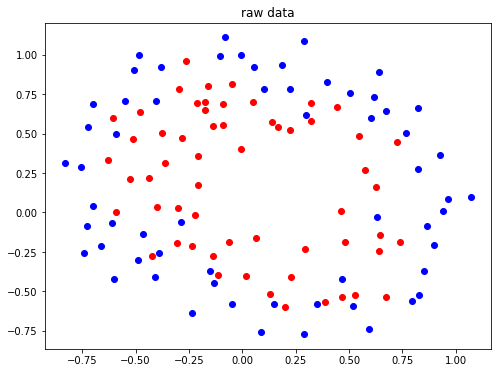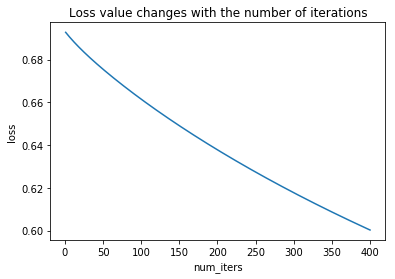logistic回归 python代码实现
2024-09-01 11:22:59
1. 读取数据集
def load_data(filename,dataType):
return np.loadtxt(filename,delimiter=",",dtype = dataType) def read_data():
data = load_data("data2.txt",np.float64)
X = data[:,0:-1]
y = data[:,-1]
return X,y
2. 查看原始数据的分布
def plot_data(x,y):
pos = np.where(y==1) # 找到标签为1的位置
neg = np.where(y==0) #找到标签为0的位置 plt.figure(figsize=(8,6))
plt.plot(x[pos,0],x[pos,1],'ro')
plt.plot(x[neg,0],x[neg,1],'bo')
plt.title("raw data")
plt.show() X,y = read_data()
plot_data(X,y)
结果:

3. 将数据映射为多项式
由原图数据分布可知,数据的分布是非线性的,这里将数据变为多项式的形式,使其变得可分类。
映射为二次方的形式:
def mapFeature(x1,x2):
degree = 2; #映射的最高次方
out = np.ones((x1.shape[0],1)) # 映射后的结果数组(取代X) for i in np.arange(1,degree+1):
for j in range(i+1):
temp = x1 ** (i-j) * (x2**j)
out = np.hstack((out,temp.reshape(-1,1)))
return out
4. 定义交叉熵损失函数

可以综合起来为:
其中:
为了防止过拟合,加入正则化技术:
注意j是重1开始的,因为theta(0)为一个常数项,X中最前面一列会加上1列1,所以乘积还是theta(0),feature没有关系,没有必要正则化
def sigmoid(x):
return 1.0 / (1.0+np.exp(-x)) def CrossEntropy_loss(initial_theta,X,y,inital_lambda): #定义交叉熵损失函数
m = len(y)
h = sigmoid(np.dot(X,initial_theta))
theta1 = initial_theta.copy() # 因为正则化j=1从1开始,不包含0,所以复制一份,前theta(0)值为0
theta1[0] = 0 temp = np.dot(np.transpose(theta1),theta1)
loss = (-np.dot(np.transpose(y),np.log(h)) - np.dot(np.transpose(1-y),np.log(1-h)) + temp*inital_lambda/2) / m
return loss
5. 计算梯度
对上述的交叉熵损失函数求偏导:
利用梯度下降法进行优化:
def gradientDescent(initial_theta,X,y,initial_lambda,lr,num_iters):
m = len(y) theta1 = initial_theta.copy()
theta1[0] = 0
J_history = np.zeros((num_iters,1)) for i in range(num_iters):
h = sigmoid(np.dot(X,theta1))
grad = np.dot(np.transpose(X),h-y)/m + initial_lambda * theta1/m
theta1 = theta1 - lr*grad
#print(theta1)
J_history[i] = CrossEntropy_loss(theta1,X,y,initial_lambda)
return theta1,J_history
6. 绘制损失值随迭代次数的变化曲线
def plotLoss(J_history,num_iters):
x = np.arange(1,num_iters+1)
plt.plot(x,J_history)
plt.xlabel("num_iters")
plt.ylabel("loss")
plt.title("Loss value changes with the number of iterations")
plt.show()
7. 绘制决策边界
def plotDecisionBoundary(theta,x,y):
pos = np.where(y==1) #找到标签为1的位置
neg = np.where(y==0) #找到标签为2的位置 plt.figure(figsize=(8,6))
plt.plot(x[pos,0],x[pos,1],'ro')
plt.plot(x[neg,0],x[neg,1],'bo')
plt.title("Decision Boundary") #生成和原数据类似的数据
u = np.linspace(-1,1.5,50)
v = np.linspace(-1,1.5,50)
z = np.zeros((len(u),len(v)))
#利用训练好的参数做预测
for i in range(len(u)):
for j in range(len(v)):
z[i,j] = np.dot(mapFeature(u[i].reshape(1,-1),v[j].reshape(1,-1)),theta) z = np.transpose(z)
plt.contour(u,v,z,[0,0.01],linewidth=2.0) # 画等高线,范围在[0,0.01],即近似为决策边界
plt.legend()
plt.show()
8.主函数
if __name__ == "__main__":
#数据的加载
x,y = read_data()
X = mapFeature(x[:,0],x[:,1])
Y = y.reshape((-1,1))
#参数的初始化
num_iters = 400
lr = 0.1
initial_theta = np.zeros((X.shape[1],1)) #初始化参数theta
initial_lambda = 0.1 #初始化正则化系数
#迭代优化
theta,loss = gradientDescent(initial_theta,X,Y,initial_lambda,lr,num_iters)
plotLoss(loss,num_iters)
plotDecisionBoundary(theta,x,y)
9.结果


最新文章
- sscanf_强大的数据读取-转换
- Clock rate
- SAP SE11 网格布局显示
- shh(struts+spring+Hibernate)的搭建
- FastDFS简介
- 面向对象的Javascript(4):重载
- 遍历input。select option 选中的值
- 7件你不知道但可以用CSS做的事
- ios 免书籍入门站点
- cygwin在Windows8.1中设置ssh的问题解决
- JAVA开源爬虫,WebCollector,使用方便,有接口。
- OC 截取字符串
- 两分钟搞懂UiAutomator、UiAutomator2、Bootstrap的关系
- POJ3580 SuperMemo splay伸展树,区间操作
- vue脚手架搭建的具体步骤
- Identical Binary Tree
- vue组件的hover事件模拟、给第三方组件绑定事件不生效问题
- 分布式缓存设计:一致性Hash算法
- Android仿新浪新闻SlidingMenu界面的实现 .
- JAVA学习必须掌握的框架,不看后悔
热门文章
- 将SpringBoot部署在外部tomcat中
- Maven 创建项目之简单示例
- selenium-04-验证码问题
- WPF中资源的引用方法
- shell 获取当前目录下的jar文件
- ServiceStack.Redis高效封装和简易破解
- Angular: If ngModel is used within a form tag, either the name attribute must be set or the form control must be defined as ‘standalone’ in ngModelOptions.
- 纯CSS焦点轮播效果-功能可扩展
- 【Autofac打标签模式】AutoConfiguration和Bean
- NOIP2014联合权值